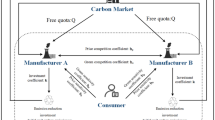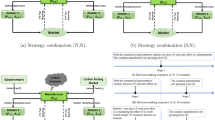Abstract
This paper applies an evolutionary game theoretical analysis combined with system dynamics to model strategic interaction between enterprises and consumers with bounded rationality in a carbon-labeled product market. Through the game theoretical analysis, possible equilibriums are predicted between these two players, in order to provide market recommendations for promotion of carbon-labeled products. The simulation results indicated that it is impossible to promote the carbon-labeled products relying on the market’s inherent functions. After incorporating dynamic subsidies, both of the players have evolutionary stable strategies, revealing it has an incentive impact on the market. Limitations of the game theoretical analysis are discussed to lay out a foundation for further study.





Similar content being viewed by others
References
Biswas A, Roy M (2015) Green products: an exploratory study on the consumer behaviour in emerging economies of the east. J Clean Prod 87:462–468
Bravo G, Vallino E, Cerutti AK, Pairotti MB (2013) Alternative scenarios of green consumption in Italy: an empirically grounded model. Environ Model Softw 47:225–234
Carbon Trust (2008) Product carbon footprinting: the new business opportunity. Retrived From: http://www.carbontrust.com/resources/reports/footprinting/ product-carbon-footprinting-the-new-business-opportunity (accessed 14/03/2017)
Chen SB (2016) Selling the environment: green marketing discourse in China’s automobile advertising. Discourse Context Me 12:11–19
Chen HS, Chen CY, Chen HK, Hsieh T (2012) A study of relationships among green consumption attitude, perceived risk, perceived value toward hydrogen-electric motorcycle purchase intention. AASRI Procedia 2:163–168
Cressman R (2003) Evolutionary dynamics and extensive form games. MIT Press, Cambridge
Dayaratne SP, Gunawardana KD (2015) Carbon footprint reduction: a critical study of rubber production in small and medium scale enterprises in Sri Lanka. J Clean Prod 103:87–103
D’Souza C, Taghian M, Lamb P, Pretiatko R (2007) Green decisions: demographics and consumer understanding of environmental labels. Int J Consum Stud 31(4):371–376
Friedman D (1991) Evolutionary games in economics. Econometrica 59:637–666
Gadema Z, Oglethorpe D (2011) The use and usefulness of carbon labelling food: a policy perspective from a survey of UK supermarket shoppers. Food Policy 36:815–822
Gintis H (2009) Game theory evolving: a problem-centered introduction to modeling strategic interaction. Princeton University Press, Princeton
Gleim MR, Smith JS, Andrews D, Cronin JJ (2013) Against the green: a multi-method examination of the barriers to green consumption. J Retail 89:44–61
Gordon-Wilson S, Modi P (2015) Personality and older consumers’ green behavior in the UK. Futures 71:1–10
Guenther M, Saunders CM, Tait PR (2012) Carbon labeling and consumer attitudes. Carbon Manage 3(5):445–455
Gupta S, Ogden DT (2009) To buy or not to buy? A social dilemma perspective on green buying. J Consum Market 26(6):376–391
Haytko DL, Matulich E (2008) Green advertising and environmentally responsible consumer behaviours: linkages examined. J Manage Market Res 7(1):2–11
Hui EC, Bao H (2013) The logic behind conflicts in land acquisitions in contemporary China: a framework based upon game theory. Land Use Policy 30(1):373–380
Ji P, Ma X, Li G (2015) Developing green purchasing relationships for the manufacturing industry: an evolutionary game theory perspective. Int J Prod Econ 166:155–162
Johnstone ML, Tan LP (2015) Exploring the gap between consumers’ green rhetoric and purchasing behaviour. J Bus Ethics 132(2):311–328
Kim DH, Kim DH (1997) System dynamics model for a mixed strategy game between police and driver. Syst Dyn Rev 13(1):33–52
Lee K (2008) Opportunities for green marketing: young consumers. Market Intelli Plan 26(6):573–586
Li J, Kendall G, John R (2016) Computing Nash equilibria and evolutionarily stable states of evolutionary games. IEEE Transac Evolut Comput 20(3):460–469
Liu T, Wang Q, Su B (2016) A review of carbon labeling: standards, implementation, and impact. Renew Sust Energ Rev 53:68–79
Mahlia TMI, Tohno S, Tezuka T (2013) International experience on incentive program in support of fuel economy standards and labelling for motor vehicle: a comprehensive review. Renew Sust Energ Rev 25:18–33
Messum D (2012) Creating change through carbon footprinting. Retrieved from: http://www.carbontrust.com/news/2012/02/creating-change-through-carbon-footprinting (accessed 14/03/2017)
Milovantseva N (2016) Are American households willing to pay a premium for greening consumption of information and communication technologies? J Clean Prod 127:282–288
Michelsen O, de Boer L (2009) Green procurement in Norway: a survey of practices at the municipal and county level. J Environ Manag 91(1):160–167
Nash J (1951) Non-cooperative games. Ann Math 54(2):286–295
OECD (2016) Green growth and consumer behaviour. Retrieved from: http://www.oecd.org/greengrowth/greengrowthandconsumerbehaviour.htm (accessed 16/05/2017)
Olive H, Volschenk J, Smit E (2011) Residential consumers in the Cape Peninsula's willingness to pay for premium priced green electricity. Energ Policy 39(2):544–550
Paul J, Modi A, Patel J (2016) Predicting green product consumption using theory of planned behavior and reasoned action. J Retail Consum Serv 29:123–124
Ramayah T, Lee JWC, Mohamad O (2010) Green product purchase intention: some insights from a developing country. Resour Conserv Recycl 54(12):1419–1427
Ritter ÀM, Borhardt M, Vaccaro GLR, Pereira GM (2015) Motivations for promoting the consumption of green products in an emerging country: exploring attitudes of Brazilian consumers. J Clean Prod 106:507–520
Seroka-Stolka O (2016) Green initiatives in environmental management of logistics companies. Transport Res Procedia 16:483–489
Shi XP (2013) Spillover effects of carbon footprint labelling on less developed countries: the example of the East Asia summit region. Develop Policy Rev 31(3):239–254
Sheehan K, Atkinson L (2012) Revisiting green advertising and the reluctant consumer. J Advertis 41(4):5–17
Tan LP, Johnstone ML, Yang L (2016) Barriers to green consumption behaviors: the role of consumers’ green perceptions. Austra Market J 24:288–299
Tan M, Tan R, Khoo H (2014) Prospects of carbon labelling: a life cycle point of view. J Clean Prod 72:76–88
Tang L, Wu JQ, Yu L, Bao Q (2015) Carbon emissions trading scheme exploration in China: a multi-agent-based model. Energ Policy 81:152–169
Thongplew N, van Koppen CSA, Spaargaren G (2014) Companies contributing to the greening of consumption: findings from the dairy and appliance industries and Thailand. J Clean Prod 75:96–105
Tian Y, Govindan K, Zhu Q (2014) A system dynamics model based on evolutionary game theory for green supply chain management diffusion among Chinese manufacturers. J Clean Prod 80:96–105
Upham P, Dendler L, Bleda M (2011) Carbon labelling of grocery products: public perceptions and potential emissions reductions. J Clean Prod 19(4):348–355
Wang Y, Chang X, Chen Z, Zhong Y, Fan T (2014) Impact of subsidy policies on recycling and remanufacturing using system dynamics methodology: a case of auto parts in China. J Clean Prod 74:161–171
Wang S (2016) Green practices are gendered: exploring gender inequality caused by sustainable consumption polices in Taiwan. Energ Res Soc Sci 18: 88–95
Wu P, Xia B, Pienaar J, Zhao X (2014) The past, present and future of carbon labelling for construction materials—a review. Build Environ 77:160–168
Wu P, Feng YB, Pienaar J, Xia B (2015) A review of benchmarking in carbon labelling schemes for building materials. J Clean Prod 109:108–117
Yang DF, Lu Y, Zhu WT, Su CT (2015) Going green: how different advertising appeals impact green consumption behavior. J Bus Res 68:2663–2675
Yunna W, Kaifeng C, Yisheng Y, Tiantian F (2015) A system dynamics analysis of technology, cost and policy that affect the market competition of shale gas in China. Renew Sust Energ Rev 45:235–243
Zhao R, Deutz P, Neighbour G, McGuire M (2012) Carbon emissions intensity ratio: an indicator for an improved carbon labelling scheme. Environ Res Lett 7(1):014014
Zhao R, Neighbour G, McGuire M, Deutz P (2013) A software based simulation for cleaner production: a game between manufacturers and government. J Loss Prev Proc Indus 26:59–67
Zhao R, Zhong S (2015) Carbon labelling influences on consumers’ behaviour: a system dynamics approach. Ecol Indic 51:98–106
Zhao R, Zhou X, Han JJ, Liu C (2016) For the sustainable performance of the carbon reduction labeling policies under an evolutionary game simulation. Technol Forecast Soc Change 112:262–274
Zhao R, Zhou X, Jin Q, Wang Y, Liu C (2017) Enterprises’ compliance with government carbon reduction labelling policy using a system dynamics approach. J Clean Prod 163:303–319
Zhu Q, Geng Y, Sarkis J (2013) Motivating green public procurement in China: an individual level perspective. J Environ Manag 126:85–95
Funding
This study is sponsored by National Natural Science Foundation of China (No. 41301639; No. 41571520), Sichuan Provincial Key Technology Support (No. 2014GZ0168), and the Fundamental Research Funds for the Central Universities (No. 2682014RC04).
Author information
Authors and Affiliations
Corresponding author
Additional information
Responsible editor: Philippe Garrigues
Rights and permissions
About this article
Cite this article
Zhao, R., Han, J., Zhong, S. et al. Interaction between enterprises and consumers in a market of carbon-labeled products: a game theoretical analysis. Environ Sci Pollut Res 25, 1394–1404 (2018). https://doi.org/10.1007/s11356-017-0595-9
Received:
Accepted:
Published:
Issue Date:
DOI: https://doi.org/10.1007/s11356-017-0595-9




